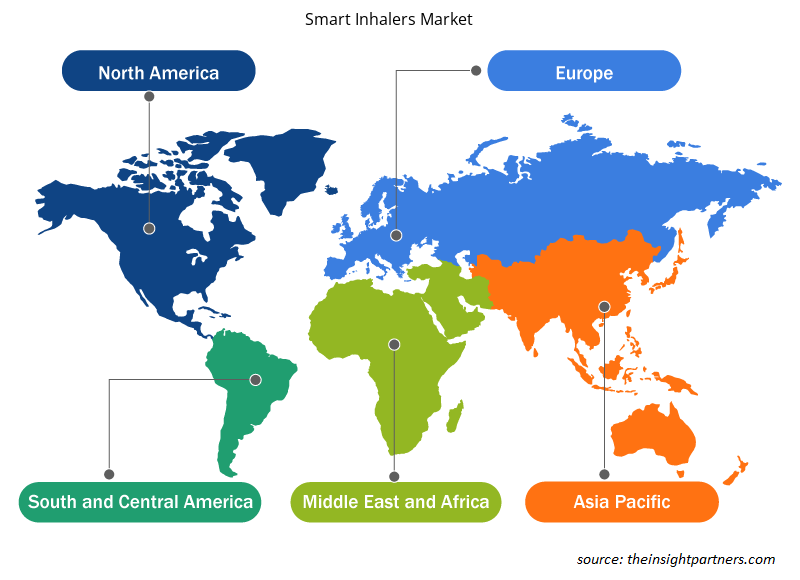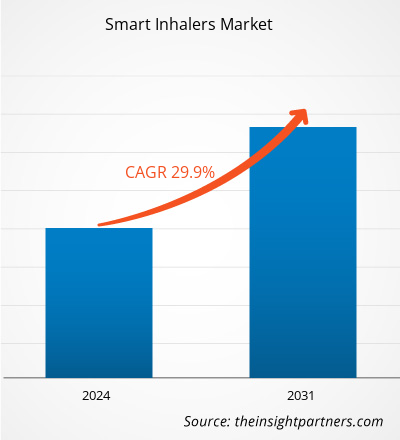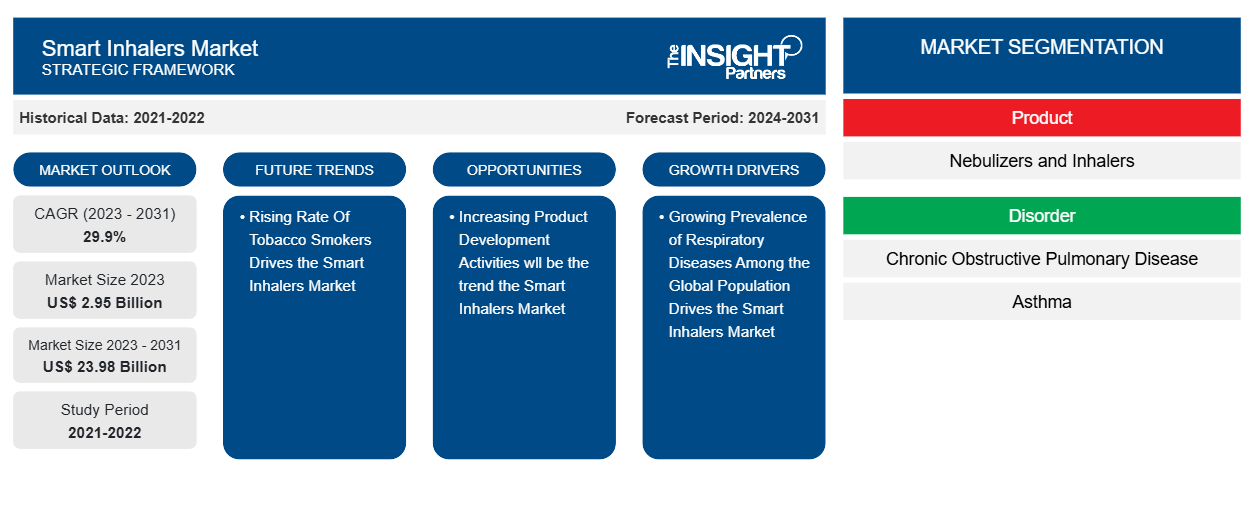智能吸入器市场规模预计将从 2023 年的 29.5 亿美元增至 2031 年的 239.8 亿美元。预计 2023-2031 年期间市场复合年增长率将达到 29.9%。移动医疗技术的接受度不断提高可能仍是市场的主要趋势。
智能吸入器市场分析
哮喘、慢性阻塞性肺病 (COPD)、囊性纤维化和其他呼吸系统疾病的患病率在全球范围内不断上升。例如,根据世界卫生组织 (WHO) 的数据,2022 年,2019 年哮喘相关死亡人数为 455,000 人。此外,2019 年的疾病负担研究记录了全球 2.123 亿例 COPD 病例,导致 330 万人死亡。此外,COPD 和哮喘等呼吸系统疾病的主要原因之一是空气污染的增加。此外,经济合作与发展组织 (OECD) 估计,到 2050 年,全球温室气体排放量可能会增长约 50%,主要是由于二氧化碳排放量增加 70%。此外,哮喘和 COPD 联合治疗对患者的有益作用有所增加,这增加了对智能吸入器的需求,因为它们是给药的最佳方式之一。因此,全球人口中呼吸系统疾病的患病率不断上升是推动智能吸入器市场增长的因素之一。
智能吸入器市场概况
推动市场增长的主要因素包括呼吸系统疾病病例的增加以及通用吸入器的普及。此外,在预测期内,产品开发活动的增加很可能成为市场未来的重要趋势。然而,缺乏早期诊断和吸入器成本高昂是市场阻碍因素之一。
定制此报告以满足您的需求
您可以免费定制任何报告,包括本报告的部分内容、国家级分析、Excel 数据包,以及为初创企业和大学提供优惠和折扣
-
获取此报告的关键市场趋势。这个免费样品将包括数据分析,从市场趋势到估计和预测。
智能吸入器市场驱动因素和机遇
吸烟者比例上升利好市场
根据《吸烟与健康行动》(ASH)情况说明书,2022 年,英国 12.9% 的成年人吸烟,其中男性吸烟率为 14.6%,女性吸烟率为 11.2%。这相当于约 640 万人。2022 年英国各国家/地区的成年人吸烟率如下:英格兰:12.7%,威尔士:14.1%,苏格兰:13.9%,北爱尔兰:14.0%。吸烟者比例上升是全球智能吸入器市场份额的主要驱动力。
增加产品开发活动
随着新的医学知识和有效药物的出现,使用各种哮喘吸入器进行治疗的进展不断加快。呼吸机联合疗法的使用率不断上升,主要参与者在开发先进的呼吸机吸入器方面的投资不断增加,这些都推动了对呼吸吸入器的需求。除了该设备具有便携性、便利性和有效性等众多优势外,预计未来几年对智能吸入器的需求将不断增加。以下列出了一些主要的发展和批准:
- 2024 年 5 月,Teva 在英国推出了一款数字化吸入器,标志着其首次亮相欧洲市场。该吸入器旨在供患有慢性阻塞性肺病 (COPD) 和哮喘的患者使用。
- 2024 年 3 月,Berry Global 推出了 BerryHaler,这是一款带剂量计数器的双室干粉吸入器 (DPI)。这款新型吸入器旨在改善患者获取药物的机会并支持有效输送组合药物。
因此,各市场参与者的不断进步和产品批准可能会在预测期内催化全球智能吸入器市场的增长。
智能吸入器市场报告细分分析
有助于得出智能吸入器市场分析的关键部分是产品、障碍和最终用户。
- 根据产品,智能吸入器市场分为雾化器和吸入器。吸入器部分在 2023 年占据了更大的市场份额。
- 根据疾病类型,市场分为哮喘和慢性阻塞性肺病。2023 年,哮喘占据了较大的市场份额。
- 就最终用户而言,市场分为家庭护理环境和医院及诊所。家庭护理环境部分在 2023 年占据了相当大的市场份额。
智能吸入器市场份额(按地区)分析
智能吸入器市场报告的地理范围主要分为五个地区:北美、亚太、中东和非洲、欧洲以及南美和中美。
北美占据了市场主导地位。2023 年,美国占据了该地区最大的市场份额,其次是加拿大,原因是该地区人群中 COPD 和哮喘的患病率不断上升。根据《默沙东手册》发表的一篇文章,约有 1600 万人患有 COPD,这是一种主要的死亡原因,每年在美国夺走超过 15 万人的生命。因此,美国日益严重的慢性呼吸系统疾病正在推动呼吸吸入器市场的增长。预计亚太地区未来几年将以最高的复合年增长率增长。
智能吸入器市场区域洞察
Insight Partners 的分析师已详尽解释了预测期内影响智能吸入器市场的区域趋势和因素。本节还讨论了北美、欧洲、亚太地区、中东和非洲以及南美和中美洲的智能吸入器市场细分和地理位置。

- 获取智能吸入器市场的区域特定数据
智能吸入器市场报告范围
| 报告属性 | 细节 |
|---|---|
| 2023 年的市场规模 | 29.5亿美元 |
| 2031 年市场规模 | 239.8亿美元 |
| 全球复合年增长率(2023 - 2031) | 29.9% |
| 史料 | 2021-2022 |
| 预测期 | 2024-2031 |
| 涵盖的领域 |
按产品
|
| 覆盖地区和国家 |
北美
|
| 市场领导者和主要公司简介 |
|
市场参与者密度:了解其对商业动态的影响
智能吸入器市场正在快速增长,这得益于终端用户需求的不断增长,而这些需求又源于消费者偏好的不断变化、技术进步以及对产品优势的认识不断提高等因素。随着需求的增加,企业正在扩大其产品范围,进行创新以满足消费者的需求,并利用新兴趋势,从而进一步推动市场增长。
市场参与者密度是指在特定市场或行业内运营的企业或公司的分布情况。它表明在给定市场空间中,相对于其规模或总市场价值,有多少竞争对手(市场参与者)存在。
在智能吸入器市场运营的主要公司有:
- 葛兰素史克公司
- Cohero Health, Inc.
- Crux 产品设计有限公司
- 艾德瑞姆有限公司
- 诺华公司
- Vectura集团
免责声明:上面列出的公司没有按照任何特定顺序排列。

- 获取智能吸入器市场顶级关键参与者概览
智能吸入器市场新闻和最新发展
智能吸入器市场通过收集一手和二手研究后的定性和定量数据进行评估,其中包括重要的公司出版物、协会数据和数据库。智能吸入器市场的一些发展如下:
- 2022 年 2 月,药物输送系统、服务和活性材料科学解决方案领域的全球领导者 Aptar Pharma 宣布推出 HeroTracker Sense,这是一款新型数字呼吸健康解决方案,可将标准定量吸入器 (pMDI) 转变为智能互联医疗设备。(来源:Aptar Pharma,新闻稿,2022 年 2 月)
- 2021 年 10 月,BreatheSuite 宣布其定量吸入器 V1 设备已获得 FDA 的 510(k) 批准,该设备可将现有吸入器转变为哮喘和 COPD 患者的智能吸入器。(来源:BreatheSuite,新闻稿,2021 年 10 月)
智能吸入器市场报告覆盖范围和交付成果
“智能吸入器市场规模和预测(2021-2031)”报告对市场进行了详细分析,涵盖以下领域:
- 智能吸入器市场规模及全球、区域和国家层面所有主要细分市场的预测
- 智能吸入器的市场趋势以及市场动态,如驱动因素、限制因素和关键机遇
- 详细的 PEST/波特五力分析和 SWOT 分析
- 智能吸入器市场分析涵盖主要市场趋势、全球和区域框架、主要参与者、法规和最新市场发展
- 行业格局和竞争分析,涵盖市场集中度、热图分析、知名参与者以及智能吸入器市场的最新发展
- 详细的公司简介
- 历史分析(2 年)、基准年、预测(7 年)及复合年增长率
- PEST和SWOT分析
- 市场规模、价值/数量 - 全球、区域、国家
- 行业和竞争格局
- Excel 数据集
近期报告
客户评价
购买理由
- 明智的决策
- 了解市场动态
- 竞争分析
- 客户洞察
- 市场预测
- 风险规避
- 战略规划
- 投资论证
- 识别新兴市场
- 优化营销策略
- 提升运营效率
- 顺应监管趋势























 获取免费样品 - 智能吸入器市场
获取免费样品 - 智能吸入器市场